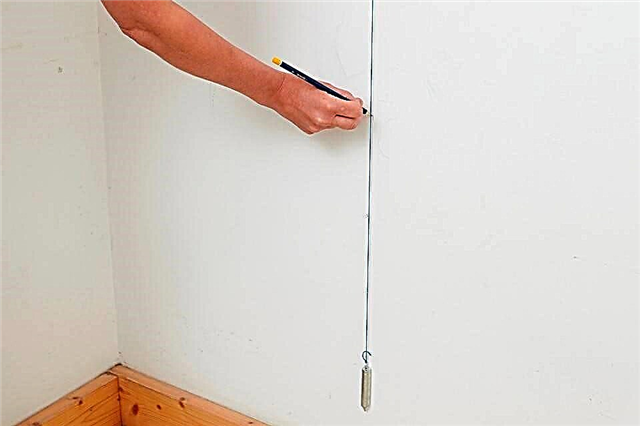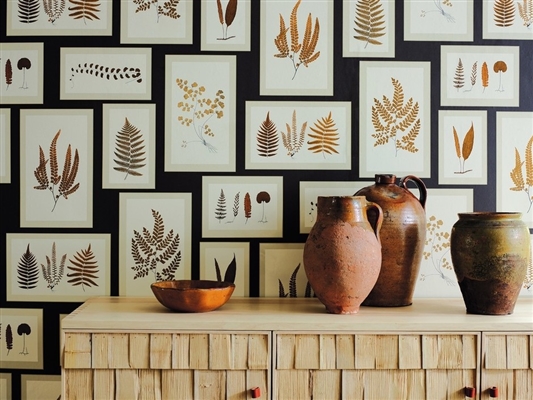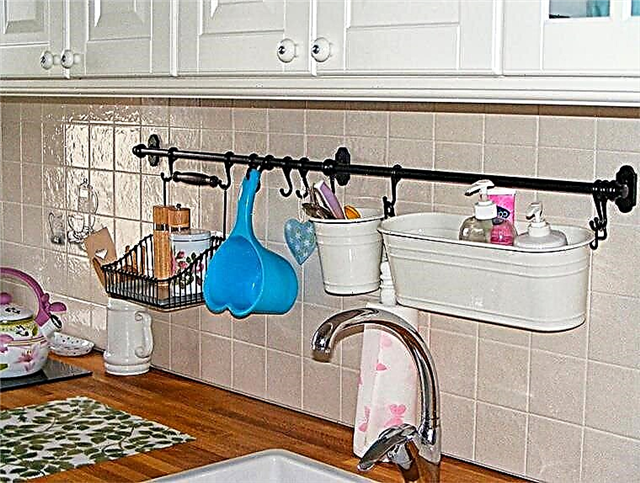PhD, site expert.
When setting the front door to the apartment, it is necessary to remember two popular sayings: "greeted by clothes. "And"King makes retinue". What is it for? Entering the room, the guest forms his first impressions of the owners and the housing is by the door. Therefore, they should look presentable, emphasizing prosperity in the house, in harmony with the decoration of the hallway and, at the same time, be reliable protection against uninvited visitors.
However, such an effect cannot be achieved without work on the device of slopes both outside and inside. They are the very previously mentioned suite that turns even the most ordinary door into the most important element of the interior of the apartment. If anyone is in doubt, you can look at the photo below, which shows the doorway without finishing the door slopes.
What are slopes for?
Near the installed front door there is always a part of the unfinished wall. Platbands are installed on its plane from the side of the landing and the apartment. Slopes are placed on the front part of the doorway. They are needed for several reasons:
- give the door an aesthetically finished look,
- isolate the hallway from the penetration of noise and cold from the entrance,
- ensure a harmonious transition from the front door to the inner surface of the wall,
- hide the mounting elements of the door frame from intruders,
- close up the recesses, cracks, cracks in the doorway.
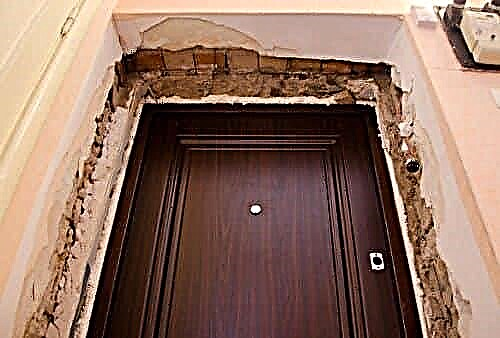
When are installed
Installation of slopes on the front door is made:
- when replacing the door unit. Installation of a new door without damaging the walls nearby will not work, especially since the installation recommendations explicitly state the need to remove old slopes,
- damage to the material of which the slope is made: cracks, shedding, deep scratches, etc. appear Defects can appear both as a result of mechanical stress, and during operation of the door due to microvibration,
- changing the interior of the hallway. Finishing the slopes of the front door from the inside with your own hands is also carried out with the new design of the corridor, when the doorway begins to fall out of the general style. The fact that the slope affects the general appearance of the room, began to pay attention recently,
- mold or mildew. A rather unusual, but with an enviable regularity, cause appears. To get rid of such a misfortune without replacing the slopes is almost impossible. Antiseptic treatment does not help, since the problem is hiding inside the finishing materials.
Plaster
One of the most conservative methods for finishing slopes is plastering. It was first used several centuries ago and immediately became the undisputed leader. With the advent of new finishing materials, the popularity of plaster slopes fell sharply. The method has many advantages:
- power tools are not used in the process,
- lower cost of finishing compared to alternative options,
- high strength - at the same time strengthens the ends of the walls in the doorway,
- insulates the technological gap
- it is easily washed away from pollution,
- tolerates jumps in temperature and humidity without consequences,
- long term of operation.
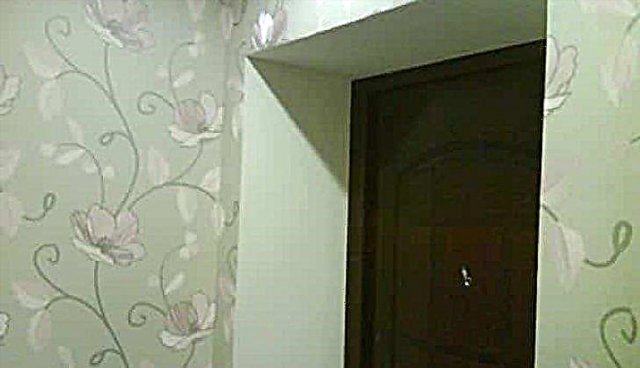

Reverse side of the process:
- laborious work
- a lot of dust and dirt
- need plaster skills
- it takes several days for the solution to gain strength,
- not the most attractive look - you can only paint or wallpaper.
On the last point you can argue. The appearance of a reflective decorative film with a 3D effect in many ways removes the problem. In addition, you can use decorative plaster, which is not cheap in every sense.
Drywall
Drywall finish of slopes leads with a huge margin among budget options. And this is not surprising, since the method has many positive aspects:
- low cost of decoration,
- high heat and sound insulation
- environmentally friendly materials
- simple installation technology available to beginner builders,
- GKL can close openings of any shape,
- long period of operation.
By cons experts include:
- poor water resistance - when the apartment is flooded, in 90 cases out of 100 it will be necessary to change the slopes. They must draw moisture from below, even if moisture-resistant types of drywall are installed,
- the need for finishing (soil treatment, puttying, painting, wallpapering, pasting with decorative films),
- low strength.
The last point can and should be argued. There are several ways to increase the strength of drywall sheets several times:
- put it on solid glue, without the formation of voids,
- buy gypsum board with a thickness of 12.5 mm (wall),
- when installing the crate, do not allow distances between the profile more than 20 cm.
Tree
Another old way of decorating slopes is by lining them with natural wood. To many, which is strange, this seems to be a manifestation of provincialism.
But expensive woods with the possibilities of artificial aging, and in several ways, make it possible to obtain a very beautiful, richly looking coating with a very long service life, both for metal entrance doors and for wooden. All minor damage can be restored. A few more advantages:
- with their help, almost perfect insulation of the space between the door frame and the wall of the opening is carried out,
- environmentally friendly material
- You can buy in a store, or you can make slopes on the front door with your own hands, using in practice the most original design ideas.
In apartments, this method is rare because of the high cost, unlike villas and cottages, where it comes first.


Laminated MDF panels
Slopes from laminated MDF panels are gaining popularity. Especially in demand are dobras made of this material.
For reference: you can also fix jambs with non-laminated MDF boards, which is much cheaper. The only problem arises: how to finish the slopes of the front door inside the apartment - paint or paste over.


The use of MDF panels for arranging slopes has many advantages. They are:
- hold medium impacts without collapsing. When heavy and bulky pieces of furniture are brought into the apartment, the risk of damage is reduced to zero,
- are available in various designs (relief, color scheme, imitation of precious wood, etc.), which makes it easy to fit into any interior, from classic to hi-tech,
- easily mounted by one person
- have good noise and heat insulation properties,
- can be installed with both wooden and metal doors.
Cons are few, but they are significant:
- panels are very expensive, second only to wood, as well as natural and artificial stone,
- sharp objects remain scratches,
- constant care is necessary - the accumulated dirt is difficult, and often almost impossible, to wash,
- can not be installed in rooms with high humidity, which, however, is not related to apartments.
PVC panels
Attempts to transfer the experience of installing slopes on plastic windows from PVC panels to the entrance doors do not give the expected result, despite the simple installation, diverse design and low cost of PVC. Here are a few reasons:
- thin material comes into disharmony with the door material, although if you try hard, you can choose acceptable types of panels,
- easily deformed and damaged - there is no sparing operation mode, as on windows,
- poorly holds geometry with deep slopes.



Sandwich panel
Sandwich panel slopes are made of plastic. But there is a significant difference from the slopes of PVC panels: the interior is not hollow with stiffeners, but filled with polyurethane sealant. On sale you can find material with a thickness of 10, 24, 32 and 40 mm and a width of up to 1.5 m.
Among the undoubted advantages:
- beautiful appearance
- good thermal insulation properties
- easy care - the most undemanding material in this regard,
- not afraid of high humidity and sudden changes in temperature,
- simple installation technology - all work is done in one step,
- no finishing required
- allows you to trim a wide slope, up to 1.5 m, with one sheet,
- has absolutely even geometry.
High-quality panels have the same disadvantages during operation as PVC panels: they are scratched and poorly washed. Inexpensive sandwich panels turn yellow over time, and also crack upon mechanical impact (shock).

Natural and artificial stone
Fashion is a capricious lady. It comes without asking, it leaves. This fully applies to slopes made of natural and artificial stone. They were very popular at the end of the last century, but then came to naught. Now the fashion for them is back. They are bought not only inexpensive, under sandstone, stone, but also natural, very expensive, marble and granite.
The stone has many advantages:
- there is no need to level the surface of the jamb,
- you can do all the cladding work yourself - the technology is similar to laying tiles,
- the material is combined with any interior,
- stones have unique drawings, shades and texture,
- not afraid of water, frost and fire,
- safe for the health of the owners of the apartment,
- durable - hard to damage
- has a long service life exceeding the door service life.
- very high price for most types of stone, including artificially created,
- requires masterly work when decorating walls at the border of two materials: slope stone and wall material.

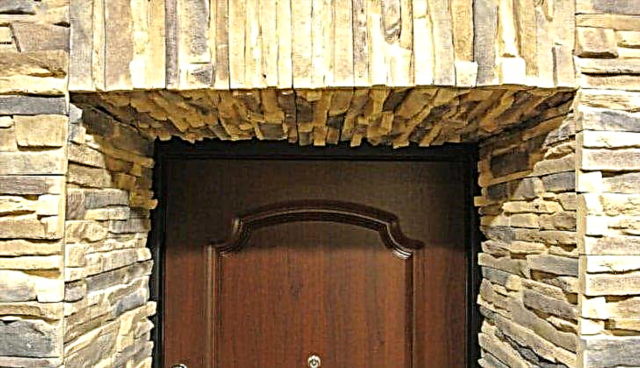
If finances allow and everything is done correctly, according to the instructions, then the stone slopes look fantastically beautiful. This is the case when the price matches the quality.
We examined the basic finishes that are quite common. In practice, many other finishing materials are used (laminated particleboard, ceramic tiles, parquet, one-sided sandwich panels, etc.).

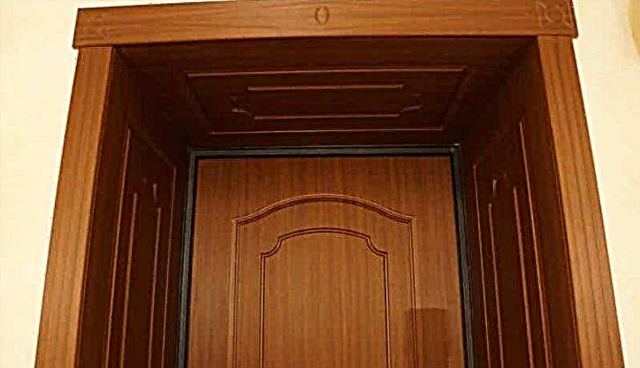


There is no sense in considering them separately, they are derivatives of the considered ones (laminated chipboard is similar in installation technology and characteristics to MDF panels, tiles with natural stone, one-sided sandwich panels with two-sided, etc.). Rarely used materials are also found: laminate and lining.
Lining
Any material from wood has undoubted advantages. In the case of slope lining, specialists and designers talk more about the minuses:
- difficult to fit into the interior,
- it’s problematic to make small slopes,
- moody about changes in humidity,
- need treatment with antiseptics and fire-retardants,
- high price, approximately equal to MDF and slightly lower than natural wood from a solid array.
As a result, experts advise in such cases it is better to spend a little more finances, but make a choice in favor of natural wood.


Laminate
Another option for finishing slopes "for an amateur" is laminate. Him:
- sufficiently high strength
- a large selection of colors and textures, which makes it easy to choose the necessary material for the design of the hallway,
- good thermal insulation properties
- easy care.

- good noise conductor
- afraid of changes in temperature and moisture
- the service life does not exceed 15 years - one of the lowest indicators among all materials used for sealing jambs.
Materials and Tools
1. Plastering with a cement-sand mixture. This is the cheapest but time-consuming way. For work you will need:
- cement with sand or dry cement mixtures,
- deep penetration primer
- putty,
- fiberglass or sickle,
- metal perforated corner to strengthen the outer corner,
- finishing materials (paint, wallpaper or decorative film),
- masking tape to protect the door frame,
- short rule
- level,
- Master OK,
- paint brush (roller) for priming the wall,
- primer bath,
- container for stirring the solution,
- electric drill with mixer nozzle for mixing solution,
- set of spatulas,
- grater,
- fine sandpaper or paint net.
Attention: a more detailed list of tools for plastering can be found in the work: "How to plaster a brick wall."
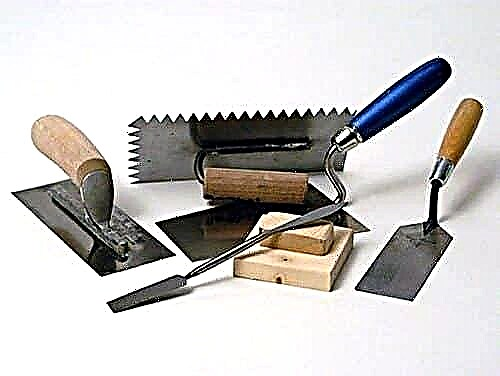
2. Sticking on the wall of finishing materials using various adhesive mixtures. This method of finishing is more expensive, but simpler and shorter in duration than the plastering process. In addition, it provides a huge selection of design solutions for the design of the interior of the hallway and entrance door. To work, you will need:
- finishing materials (drywall, panels made of PVC, chipboard, MDF, natural wood boards, etc.),
- adhesive mixture (specialized glue, putty, polyurethane foam, dry gypsum plaster),
- primer,
- antiseptic solutions
- level,
- set of spatulas,
- paint brush
- cuvette for primer,
- construction pencil
- roulette,
- long, flat object for drawing a cut line on panels or gypsum plaster,
- cutting tools (drywall knife, hacksaw for panels or grinder with a cutting wheel),
- a container for stirring the solution or glue, if it was bought dry,
- construction mixer or electric drill with nozzle.
When working with drywall, you will need a perforated corner to strengthen the corners and a sickle to seal the joints of the upper slope with the side.
3. Fastening slopes to the crate. The method is available only with a significant gap between the door jamb and the frame. If it is 2-2.5 cm, then the only option is glue.
The method has many advantages: quick installation, a convenient case to hide various cables, the ability to make an opening with a significant "dawn" and install hidden lights to illuminate the inner doorway. The disadvantages of the method, neither consumers nor experts note.
In the process of work will be required:
- facing materials
- whetstone for the frame - from wood, metal or from a metal profile,
- dowels with self-tapping screws for fixing the crate to the wall,
- self-tapping screws or “liquid nails”,
- antiseptic
- drill with a set of drills,
- screwdriver or Phillips screwdriver,
- drywall construction knife,
- grinder for metal cutting,
- wood file,
- level,
- plumb
- roulette.
When working with GCR, the materials listed in paragraph 2 will be additionally required.
With everything you need on hand, you can get to work. Consider how to make the slopes of the front door with your own hands from various materials.
Plastering
Step-by-step works are performed in the following order:
- the ends of the walls are preparing for the application of cement-sand mortar: old plaster is removed, the remaining fasteners are cleaned, the surface is cleaned of dirt, weakly adhering pieces of brick and peeled concrete. The foam protruding from under the box is cut off
- the doorposts are primed twice. The second layer is applied after the first has dried. The beam above the door is processed by Benonocontact, also twice,
- the outer corners are strengthened by a perforated corner, which will simultaneously serve as a beacon when applying the solution. It is fastened with putty,

- the second lighthouse, also from the plaster corner, is placed on the screws near the door
- the box and the door leaf are closed with plastic film, which is fastened with masking tape,
- DSP is diluted in the ratio of sand and cement 1 to 1, for applying "spray",
- sprayed
- after drying of the first layer the second is applied - soil.The solution for it is prepared according to the instructions, with the addition of fiber to reduce shrinkage and prevent cracking. The soil layer should not exceed 3 cm - otherwise, the procedure must be repeated,
- after the soil gains strength, but does not completely dry, a finishing operation is carried out - a thin, 1-2 mm thick layer of grout is applied, on the plastering tongue - a coating that allows you to get a smooth surface. If the slopes are pasted with wallpaper or decorative film, this is enough. Under the paint, the surface of the plaster is putty.
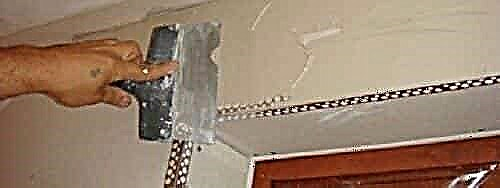
The technology of plastering is considered in detail in the work: “Plastering walls on lighthouses with your own hands.”
MDF panels
The frame method is used with a technological gap of more than 3 cm. For the elements of the frame for drywall, you can use all types of bars, including a metal profile, for panels only wood.


The work is carried out in the following sequence:
- the tree is treated with an antiseptic, and then cut to size,
- using the dowel-screws, the block is vertically attached to the opening close to the box and flush with the edge of the wall on the other side,
- horizontal strips are fastened if the panels are fastened with liquid nails (when fastening with self-tapping screws, two vertical strips are sufficient),
- all cells are filled with insulation - the procedure is mandatory,
- slope dimensions are measured,
- the panel is cut in accordance with the obtained measurement results,
- with the help of liquid nails or self-tapping screws MDF is attached to the crate.
Pvc panels
A more or less erudite landlord knows that plastic panels are attached using special profiles fixed to the wall. These stripes are always visible and taken for granted. But not in the case of slopes.
Here you can mount the panels in a special frame (they will be located horizontally) or take on glue. However, there is a limitation: the slope width cannot exceed the panel width, because Docking seams are not provided.
The operations are performed in the following sequence:
- preparing the surface of the wall. If the height differences are more than 2 mm per meter, surface plastering or puttying is carried out. The type of work depends on the curvature of the surface: a large difference is eliminated by plaster, up to 1 cm - by putty,
- the walls are measured, after which the slopes are cut. As in the case of drywall, when starting the panel behind the door frame, its width increases by 1 cm. It is necessary to trim from the side of the tenon,
- to increase adhesion (adhesion), the wall is treated with a primer, and the plastic on the back with sandpaper,
- the adhesive mass is applied around the perimeter with a continuous tape, and inside the panel with a snake,
- the slope is pressed against the wall and immediately comes off. In this way, glue is applied to the wall, which is absorbed into the pores and seizes. After 5-7 minutes, the slope fragment adheres completely.
Artificial stone
When working with stone, artificial or natural, the main thing is to draw up an arrangement of each element, draw it in real scale on the slope and wall, if it comes in the form of a casing, and lay it out on the floor.
The stone is fixed with glue or a special mixture according to a seamless method. Seams are present when facing slopes with ceramic tiles. The wall should not have differences exceeding 1 cm. If more, then the alignment of the DSP is carried out.
Clapboard
Lining is mounted on a wooden crate with screws. To prevent the material from cracking, holes for self-tapping screws are pre-drilled with a drill. The diameter of the drill should be 1-2 cm less than the cross-section of the screws. Hats can be flooded and sealed with a special composition, and can remain in sight. This is a matter of taste of the owner.

Conclusion
The choice of slopes became a headache for the owners because of the huge number of possible options. Can be used:
- plaster, including decorative,
- drywall
- natural wood
- laminated boards MDF and particleboard,
- PVC panels
- artificial and natural stone,
- lining
- tile,
- laminate,
- sandwich panels single or double sided.
For fixing the facing material, the adhesive method and the frame method are used. The main thing when choosing is to enter the slopes in the interior of the apartment.
What are door slopes?
The slopes are a small section of the wall located around the door frame (outside and inside it).
In recent years, their arrangement is mandatory, because they not only adorn the overall appearance of the door space, but also Begin the overall design of the corridor or rooms.
Types of finishing materials
Choosing the right material, we can safely say that in the process of finishing slopes you will find success. If you are a beginner builder or do not have a lot of time and money, do not take on ways that require truly significant skills and experience.
In order not to be mistaken, you need to know what materials suitable for creating a beautiful space around the front door.
Features
When the doors are already installed in the apartment, many people think that protection from external factors, such as noise and cold, is provided. But it is not so. It is necessary to make additional decoration in order to complete the repair and give the doorway a harmonious appearance. From the outside, the entrance doors are always trimmed with platbands or with a special solution during installation, but the internal slopes of the master during the installation of the door frame are always left to the discretion of the owners of the house.

Finishing slopes is not part of the installation of the door. That is why concrete, brick or other materials without external decoration are right in front of our eyes. To hide all this, it is necessary to correctly form the slopes. Not all companies that install doors provide additional services for the design of slopes. That is why this task is very often passed on to the shoulders of the owner of the house, and he has to perform these works on his own.

The purpose of the installation of this element is to give an elegant appearance to the door and the doorway, as well as to give completeness to its outlines.
In addition, door slopes are installed in order to hide from prying eyes all door fastenings and increase protection against burglary. In addition, with their help they provide heat and sound insulation, as well as protection against dust and dirt flying from the street or from the landing.
Slopes are a very important and necessary element, which can make the doorway more presentable and neat. They are a beautiful decoration that complements any hallway. Slopes are designed in accordance with the style of the front door, as well as in accordance with its color scheme and with the stylistic design of the hallway. That is why the right choice of slopes is a very important task.
Apart from the decorative function, the slopes also very effectively insulate the door frame and allow you to hide the joints between the box and the wall. Slopes also hide mounting foam. Thus, this element also allows you to additionally perform the role of thermal insulation. Polyurethane foam, located in plain view of the room, absorbs moisture and loses its protective properties, and at the same time it looks very neat.
Thus, door slope is a very important element that is paid attention to during repair.
Three main slope systems for door structures are distinguished, differing in the method of installation:
- Application of cement to the wall and subsequent plastering. Such a finishing system is considered the most reliable and fairly cheap. But not everyone can cope with such a task, it is a very laborious and painstaking process. In order to create very even and high-quality surfaces, it is necessary to have the skills to prepare the correct stucco mortar and experience in its uniform application and distribution.

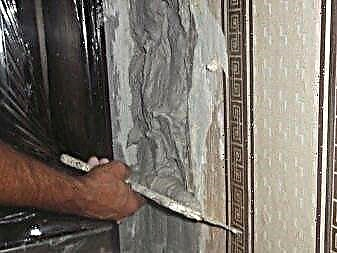
- Slope clearance system using panels and special glue. In this case, an adhesive mixture is made and ready-made finishing panels are applied to it. This principle is quite expensive. In another way it is called wet.
This process is very long, since each layer of glue needs to dry well before you apply the next layer. But even with the long duration of such work, they are quite simple and even a beginner in the installation business can cope with them.
Fastening the finish to an already finished frame. This is a very simple and quick way that allows you to achieve perfect in shape and very neat door slopes. So you can not only hide from prying eyes a concrete wall, bricks and foam, but also close all wires and other communication networks.
In addition, you can independently install additional lighting devices in the door frame and play beautifully with light in this area of the room. This option is suitable for panel apartments, as well as for a private house.


The only drawback of this method is the low strength and susceptibility of finishing materials even on a steel frame to mechanical stress. Thus, this option will be more prone to hacking. As a rule, it is used for finishing wooden door structures inside an apartment.
For more information on how to slope the front door from MDF, see the next video.
The main options for finishing door slopes
Despite the apparent diversity of building materials and how to work with them, there are not many options for designing door slopes - in addition to ready-made fittings.
| Material for slopes | Mounting method | Advantages | disadvantages | Finishing adjacent surfaces |
| Wood in the form of panels, lining, additional elements, planks, mosaics | On the crate (frame) | Eternal classic, ease of installation, relatively low cost, attractive appearance | Requires a protective coating, fuel, with insufficient surface finish it quickly gets dirty | It looks best next to a wooden door. In this case, it is desirable to select the same breed. Walls can be wallpapered, painted, plastered, lined with fabric and so on. |
| Vinyl or metal siding | On the crate (frame) | Optimal for outdoor decoration, tolerates weather changes, does not fade | It requires careful adjustment and use of additional elements - corner strips, mounting profile, and so on. | It goes well with metal or laminated door leafs, textured and decorative plaster, painting |
| Laminated MDF panels | On the crate (frame) | Inexpensive, easy to install, you can choose the color and texture | Short-lived, sensitive to moisture, easily damaged. | Suitable for doors with a laminated surface, wallpaper, paint and plaster |
We analyze the listed types of design separately.
Surface preparation
This is a required item for most of the options listed. Only panels and strips fixed to the crate can do without leveling the slopes. But even in this case, it is advisable, even in draft form, to smooth the surfaces and insulate them. The insulation is conveniently laid in the cells of the crate.
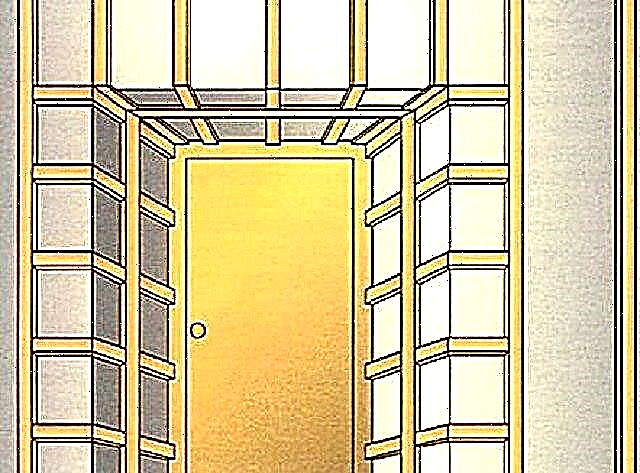
If you plan to use a material that is mounted on glue or which needs the most even surface, it is advisable to perform preliminary alignment using plaster or drywall. In both cases, you can form a beautiful contour with clear angles or a graceful arch arc.
It is easy to lay a heater under the drywall panels.

With this hold-down of the insulation, a gradual expansion of the doorway can be formed, as shown in the photo above.

Plastering slopes is carried out either directly on the supporting wall (concrete, brick or block masonry), or on top of sheet insulation - polystyrene or extruded polystyrene foam.


For plastering on insulation, a reinforcing mesh is required - it significantly improves the adhesion of materials and strengthens the plaster layer.
The surface around the doorway will also have to either be patched up (leveled) with plasterboard or plastered.
Finishing materials with glue or thin-layer decorative plaster will require finishing putty - it removes small irregularities and hardens the layer of rough plaster.
Door Extras
These decorative elements are usually sold complete with door leaf and frame or ordered according to the size and depth of the opening. You can find out exactly how to make the slopes of the front door with your own hands from finished extensions only from the manufacturer's instructions - despite the similarity of the installation technology, in each case there may be some nuances.

Door slopes on an entrance door from panels or levels
These options for the installation method do not differ much, so it makes sense to consider them together.
- marking the slopes for the installation of the lathing (frame) and their installation. Elements of the frame can be wooden or metal. In the second case, it is advisable to use a special profile for the installation of drywall. For more details on how to install such a frame, read the article. You can find out more about the features of mounting an arch frame for subsequent cladding here,
- after fixing the frame and checking its position, try on the place of the panel / board. Trimming is performed so that it is possible to smoothly box elements in the corners. For panels and boards with a thickness of 0.5 ... 3 cm, it is advisable to cut at an angle
- further prepared panels are mounted in place. They can be fastened to the bars / crate profile with self-tapping screws or “liquid nails”. The second option is preferred for light materials,
- external elements are fixed in place - platbands and additional fittings that close joints.
Depending on the quality of the material and the features of processing its edges, you can first put a corner on the edge of the doorway, and then attach a platband on top of it, as shown in the video.If the ends are carefully processed and they can be reduced without gaps and defects, you can do without corners and other “camouflage" parts.
To seal the cracks and easier docking of the panels, you can use not an external corner, but curly skirtings with a small cross section.

The corners between the platbands can easily be filled with special inserts.
The junction of the slopes to the front door is also desirable to close additional elements.
Another interesting way to decorate the slopes of the front door from the inside with a tree is shown in a master class. It is suitable for cases where adjacent walls are already lined with wood (clapboard, block house, imitation of timber, and so on) or are made of relatively soft materials - for example, drywall. The video shows the fastening of the board to the sheathing on nails, but sometimes it is more convenient to use self-tapping screws.

After fixing the board on the slope on top of it on the "liquid nails" are attached carefully trimmed diagonally corners. The doorway takes on a completed look.
How to make slopes on the front door with the installation of panels on glue or foam
This method is suitable for a relatively small roughness of slopes, where insulation is not required and there will be no significant mechanical stresses.
As a means for installation, special foam adhesive is used.
It can be applied to the panels themselves, immediately fixing them in place, but the option shown in the video is more convenient.
With this technology, the panels are trimmed exactly to the size so that when installed in place, the side bars support the top. The lower part of the side strips can be propped up with heavy objects or put into guides (if a certain distance from the casing to the base surface is required).
The top panel is attached first. It is attached tightly to the thrust surface (door frame) and is slightly deflected by the outer end down. Foam is blown into the resulting slit so that it is evenly distributed over the entire surface, but does not crawl out.
By the same principle, side strips are mounted.
All that remains is to close the joints with the corners or first mount the platbands.
It is advisable to cut the plastic corner at the corners so that it fits snugly on the panel and wall.
To fix the corner, the same foam or glue “liquid nails” is used.
This method of plating can be considered one of the cheapest and fastest.
Similarly, you can finish the opening both inside and out with sandwich panels and drywall. When using the latter option, further finishing is required.
How to make slopes on the front door as attractive as possible
If the frame of the front door was made of drywall or stucco, it needs to be finished. To do this, paint, decorative plaster, tiles of various kinds and - occasionally - wallpaper are used.
The issue of painting and wallpaper is quite simple - they are selected according to the general design of the corridor. If we are talking about the outside of the door, the wallpaper, of course, is not suitable, paint is required for outdoor work with increased resistance. For interior decoration, it is better to choose wallpapers not paper, but more durable non-woven or vinyl. An even more suitable option is fiberglass for painting. More details about different types of wallpapers and their suitability for certain rooms can be found here.
On the coloring of walls with water-based paints on our website there is a thematic article.
In the same as for decorative plaster, there are several nuances:
- doorway is always a place with an increased risk of mechanical damage. Therefore, you should not choose a relatively fragile plaster with a high relief, it will be damaged sooner or later,
- protruding elements easily cling to the outer clothing of the incoming, so the relief of the plaster should be smoothed,
- the best option can be considered compositions with stone chips.
Since the area of the slopes is small, it is desirable to perform smooth plastering or to design the elements in the same way as the walls of the corridor.
An interesting option may be a relief border along the outer edge of the opening or a relief platband.

Doing the slopes on the front door with your own hands using tiles or artificial / natural stone is carried out according to the same principle as facing these materials with a regular flat surface. Preliminary preparation is required, installation is carried out on tile adhesive or cement mortar.
Typically, such a lining "comes" on the walls of the corridor.
The cladding process is shown in more detail in the video.
MDF panels
MDF panels are a popular material that is great for these purposes. As a result variety of colors panels can be used to trim slopes in almost any interior.

Installation takes place using conventional or liquid nails, as well as self-tapping screws, corners or platband are superimposed around the perimeter.
Among the positive properties, the following should be noted:
- able to withstand shock and damage of small force,
- have an attractive appearance,
- easily mounted by one person, do not require the help of professionals,
- reminiscent of various types of wood, which allows you to make the appearance of slopes visually expensive and sophisticated,
- have good noise insulation properties.
Of the disadvantages for the panels is characterized by the fact that they can not withstand scratches and strong impacts, as well as can change their appearance and structureif they will be installed in rooms with high humidity (for example, baths and saunas).
In addition, undergoing various pollution, require careful care otherwise it will be practically impossible to wash them.
Stone decorative tiles
Stone decorative tiles attached to a special solution. In the interior, decoration with decorative tiles looks interesting and expensive.
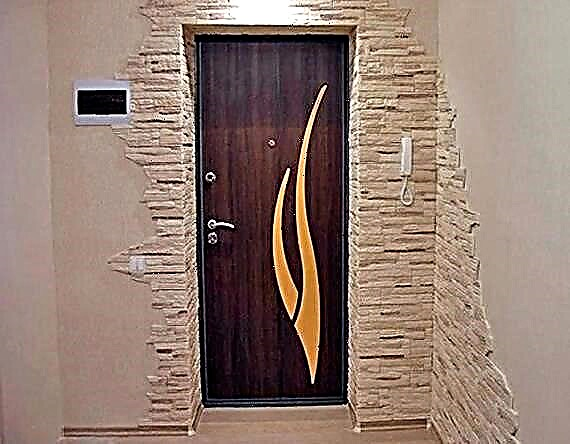
The benefits include:
- has a lower cost than natural stone,
- light weight
- does not require special care,
- due to its wide color gamut, it is able to imitate the appearance of any stone,
- able to withstand significant temperature fluctuations,
- resistant to moisture.
The main the disadvantage is the fragility of the material. In rare cases, the size of the opening will coincide with the size of the tile, so its installation almost always requires the ability to correctly and accurately trim the tile to avoid cracking.
Choosing a heavy tile, it is likely that on the top of the slope it will lag, creating danger for human life and health.
Plastic
Plastic trim is good for a doorway just because you don’t need to spend a lot of money on its purchase, it is lightweight, can imitate various textures and materials, and is also easy to care for.

Among the shortcomings can be noted - its fragility, because even with the slightest impact and effort, it is simply deformed and broken.
Decorative rock
Decorative stone is a material with a huge number of positive properties. Decorative stone finish quite expensive compared to other materials, but also looks more luxurious in the interior, as shown in the photo.

Benefits:
- completely environmentally friendly material,
- installation does not need a perfectly flat surface,
- perfectly withstand high temperatures, a large amount of moisture,
- unlike natural stone, it has significantly less weight,
- wonderful appearance, variety of textures allows you to please the tastes and requirements of any buyer,
- can be mounted in a doorway of any shape and size,
- it doesn’t burn, it retains heat well in the room,
- it is perfectly washed and does not absorb extraneous odors.
Of the minuses of decorative stone, only that it is not recommended to use it for exterior decoration of doorsthat immediately go outside.
Under the influence of very low temperatures in severe frosts, the material may slightly decompose.
Vinyl
Vinyl is great for openings that have a non-standard value. It can withstand high and low temperatures, easy to install and maintain.
Due to its appearance and shape, vinyl slopes do not need additional design around the perimeter of the doorway.
Of the negative properties of vinyl, it should be noted that it is made from materials, capable of releasing harmful substances into the atmosphere. Really durable and high quality will be those models for which you need to pay a high cost.
How to make the slopes of the front door with your own hands?

Drywall slopes can be made quite quickly, if, first of all, prepare all the necessary tools. To work, you will need a clerical knife, a long ruler or a straight rail, tape measure, level, pencil, drill, screwdriver, puncher, putty knife and hammer.
Before performing construction work, you need to check that the base of the wall is at a sufficient distance from the edge of the door slope. This is necessary in order to the future surface of drywall did not go beyond it.
Do you know how to make an interior arch with your own hands? All information in this article.
The main stages of drywall installation:
- By measuring the amount of side slope, cut a blank from a sheet of drywall, which must be necessarily 1 cm wider. If this is not done, then the sheet cannot be inserted between the opening and the box.
- By making a knife with a recess in the mounting foam passing between the door frame and the opening, insert a side cut sheet into it. Bending it slightly on the other hand, use a gun along the entire length to apply the mounting foam.
- Press material well against the wall. Make sure that there are no distortions. The sheet should be placed strictly vertically. Fill all slots with foam.
- Performing all the above actions, in the same way fix the second vertical slope.
- Measure the top of the opening and from the drywall sheet cut sheet identical in length, which will be 1 cm wider (for the same purpose as the side segments).
- In the mounting foam, make a recess, where to get the resulting piece of material. Use the level to check the correctness of the angles between the lateral and upper slope.
- Glue the sheet with mounting foam, pressing it well against the base of the wall.
- After the foam has completely dried (it will take 1 day), you can begin to apply finishing materials to drywall.
This video shows step by step how to make the finish of the slopes with your own hands.
What to issue?
Registration of slopes - an important stage in the whole work of creating a doorway. You need to start it by creating corners on drywall using putty.
You need to do this in the same way:
- Using a spatula, apply a small layer of putty to the corner.
- After waiting for its complete drying, we apply a sickle, which is covered with another layer of putty.
- When the second layer is completely dry, a finishing putty is finely applied to the corners. In this case, any irregularities must be avoided.
If you plan to paint such slopes, then the entire surface of the drywall must also be plastered twice. In the event that wallpaper will be completed, the sheets may not be further processed.
Creating beautiful door slopes is not a very difficult job that any man can do, without resorting to outside help. The main thing is to preliminarily study all the necessary recommendations, consult a specialist and purchase those materials that will be simple and easy to work with.
What do repairs first: floor or walls?
Hello. In the repair begin with the walls, since the whole range of work on these surfaces is rather dirty and time-consuming. First, the roughing works - the walls-floor, then the finishing work - the walls-floor.
If we talk about the general order of decoration, it usually looks like this:
- A complex of dismantling and rough works, preparing sites for heating radiators, wiring of electrical wiring, ventilation and other communications,
- Arrangement of the subfloor: waterproofing the base, lay pipes, pour concrete screed. After drying, the floor should be covered with cardboard sheets and cellophane,
- A set of drywall works (if planned, then somewhere here), including partitions,
- Installation of window sills (internal) - can be done before or after the walls are aligned. It all depends on the specific installation methods,
- Puttying the surfaces of walls and ceilings - is done depending on the selected options for materials and finishes.
- Installation of interior doors.
- Preparation of surfaces for the installation of flooring - is needed if it requires finishing technology,
- Finishing walls (tiles, wallpapers, painting plaster and other coatings),
- Laying flooring (parquet, wooden floor, laminate, self-leveling floor, linoleum, etc.),
- Installation of floor skirting boards and floor finishing (if necessary) - painting, varnishing, etc.,
- Installation of sockets, switches, lamps, etc.
This order approximate - the order of the finishing work may depend on the type of materials, technology, convenience and extent of repair.
Paint
This is one of the most popular coatings, which allows you to very bright and interesting to design a door slope. You can make it an interesting accent of your hallway. In addition, you can choose the paint and the color of the door. In this way, even a metal door can be designed. You can buy water-based paint or use the usual option. In addition, you can apply a beautiful textured pattern, which will look very original and will become an adornment of any hallway.

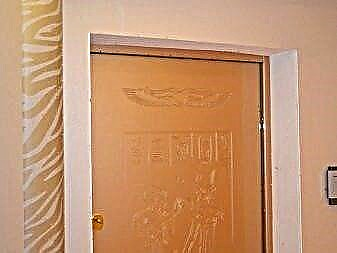
This is a great solution for those who decided not only to change the door in the hallway, but also to completely repair the corridor. To decorate the door slope with wallpaper is quite simple, but this requires an even base. Very often the walls use the same wallpaper as on the slopes. This gives the impression of a monolithic surface. Thus, it is possible to visually expand the doorway and the hallway as a whole.


Single Sided Sandwich Panels
These panels are a sheet of polymer plastic onto which a layer of extruded polystyrene foam is glued. It has a rather dense texture, which has excellent sound insulation properties and acts as great option for insulation. Thus, you will not need to additionally insulate the doors and take special measures for sound insulation.

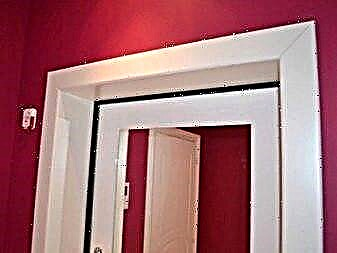
Such panels are very light in weight and therefore hold well on the door even on special glue without additional fasteners. In addition, their design can be the most diverse, there are even models for wood and products that mimic other materials and surfaces.
Parquet board
This natural quality material is perfect for decorating door slopes. Usually it is chosen for wooden doors or for the color of the flooring. It is important to choose the most precisely suitable tone, texture and relief. Thus, this composition will look very beautiful and harmonious. Manufacturers represent a huge number of types of parquet boards, which externally can match any wooden door, especially models under wenge are especially beautiful.
Which drywall to use?
Any drywall is a layer of gypsum between two strong cardboard sheets. This is one of the easiest materials to install.They allow you to smooth the surface without putty and primer. Even a beginner in this business can handle the installation of drywall sheets.

In addition, this design of slopes allows you to get rid of excess debris that could occur when using a different finishing method. In this case, the slopes turn out to be perfectly smooth and even, which gives room for imagination and their further design.
To design slopes at the front door, it is important to take not standard models, but materials that are distinguished by quality and water resistance. It withstands well the increase in humidity inherent in the hallway. To ensure greater security, it is better to give preference to sheets with the addition of fiberglass, since such a material is fireproof and provides insulation of the input structure.
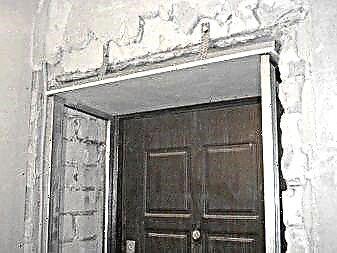
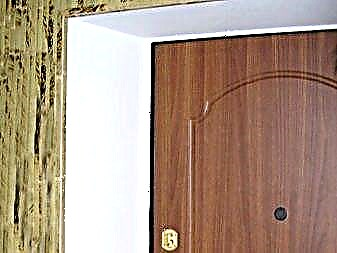
How to close up for a metal sheet?
To finish the slopes at the metal entrance door, the frame method is most often used. To create a foundation, it is necessary to use metal profiles. Acceptance is also finished with wooden blocks. It is important that the web is snug against the surface.


To strengthen the metal door frame, you must install jumpers on the supporting part of the structure. Especially important is their installation at the corners of the structure. At this stage, it is possible to lay cables and other wires. After this, it is necessary to fix the selected fabric with screws or nails.
Sealing the slopes of metal doors with a cement-sand slope is also very popular. But for this it is necessary to level all the slopes with a primer and emphasize the subsequent installation of finishing materials. For metal construction it is important to consider the thickness of the mortar layer and the thickness of the finishing materialso that this finish is not too massive and does not violate the overall picture of the door structure.
Drywall is perfect for sealing slopes near a metal door. This is due to its small thickness and versatility. But this material requires additional insulation.
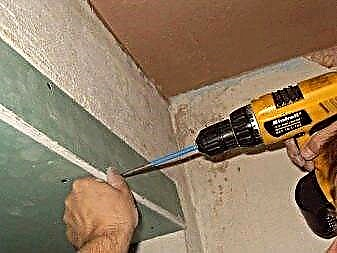

Finish after installation
After installing the door, it is important to correctly form the slopes in order to ennoble the appearance of the entrance to the house as a whole. This can be done easily with your own hands, the main thing is to properly align the door slopes from the inside. A very interesting option for finishing after installing the doors is the use of extras. You can also use the following options.
Natural or artificial stone
This is a rather elegant and beautiful option that performs a decorative role. It is quite expensive, especially when it comes to natural stone. This method has many advantages, since the material is considered very durable and high quality. Natural stone is a completely environmentally friendly option that is resistant to external mechanical influences.


But cheaper artificial stone is not of the same quality. It has a large number of disadvantages, since it is made on a gypsum basis. It is easily damaged and wrinkled. In addition, it can easily crumble or deform from exposure to water or in high humidity.
Tile
This method of decoration after installing the door is quite complicated. Not all tile options can be used for this. In particular, it is better to avoid using glazed models, because they will look very strange and cheap on door slopes. It is best to prefer clinker tiles.
This option can imitate brickwork or natural stone. Therefore, it can be selected for anyone with a stylistic design of the hallway. It is best to choose not too easily soiled and not glossy tiles. This finish option is good because these surfaces are quite easy to care for. In addition, manufacturers represent a wide variety of models for decoration.


Decorative plaster
This is a very interesting, but rather time-consuming installation option. Applying decorative plaster is a whole art, so this process is best left to professionals. But in the end, the slopes and the space around the door can significantly change.
All finishing methods are used both individually and in combination with each other. So you can not only beautifully design the door structure and slopes, but also make the door more reliable, insulate and protect it from external factors and from breaking.

Installation and design options
There are two main options for mounting slopes:
Before proceeding to the decoration, it is necessary to make sure that the structure is installed correctly, that the exact parallel between the opposite borders of the door frame and the tightness of all seams are observed. First of all, it is necessary to check the design for cracks. To do this, light a match or a candle and hold it along the entire doorway. Where the flame begins to deviate or even go out, it is necessary to additionally warm the slopes and add sealant.
When all the insulation work has been completed, you need to cut off the excess dried layer of mounting foam and additionally close the door frame with masking tape. Thereafter It is important to get rid of old plaster and loose concrete and brick wall elements.
After this, it is necessary to proceed to plastering. First you need to completely clean the wall of building dust and level it. Then you need to use a deep penetration primer. It will make the base of the frame more durable and even.
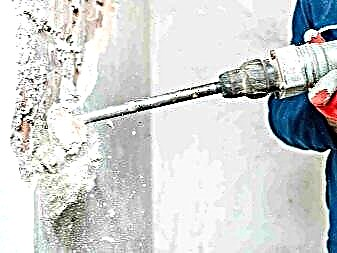

It is very important to pay special attention to the concrete lintel on the door. For its processing, it is better to use the so-called concrete contact.
If the surface does not absorb moisture well, then special soil must also be used. After the soil layer dries, you will need to install profiles. But before that, it is better to wait about 8 hours until completely dry. Profiles are necessary in order to smooth the layers of plaster on all slopes.


To do this, it is necessary to mark the position of the vertical line at the side of the door with a laser or simplest level at about 3-4 cm. There it is necessary to drill several holes with a diameter of 6 mm in increments of 30 cm. Dowels are inserted into the holes, and then the level of their caps is leveled with twine. After installing all of these items it is necessary to check their correctness and even vertical. According to the same principle, it is necessary to install a profile on top and on the opposite side of the doorway.
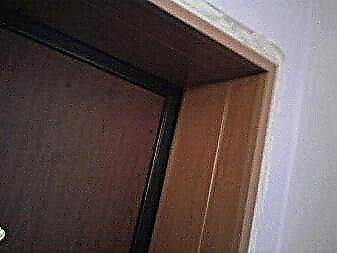

After the installation process is complete, it is necessary to make a cement mixture. It is best to use sand and cement of the M150 brand for this. All these finishing materials must be sieved through a sieve with small cells. To create a high-quality solution, it is necessary to mix sand with cement in a ratio of 3: 1. In the dry mixture, you need to gradually add clean water and at the same time stir the resulting solution with a special drill nozzle.
When the mixture becomes homogeneous and thick, like dough, the solution can be used to finish the slopes. Using a spatula, it must be sharply and quickly thrown onto the wall and ironed, closing the profiles. Thus, you can make a perfectly flat surface without unnecessary deformation.
The panel-less option without a frame is simpler. At the same time, laminate, drywall, sandwich panels, MDF, chipboard and other options are often used. And you absolutely do not have to smooth the surface of the slopes. Finishing is carried out by mounting on glue. It is important that the surface is straight. There should be no defects or bumps on the surface.


Even if the door frame itself has some defects, they can be corrected with the help of such a design of slopes. In this case, it is necessary to plaster the door exactly in places lacking for a flat surface. If the original surface is even and smooth, then finishing with the frame method will be very simple. Initially, you need to apply soil to the base, where the panels will be fixed.
Then you need to measure all the slopes and choose the right amount of finishing materials. On the panels you need to make all the notes and put dots. Then you need to connect all the lines and check them using a tape measure and a special square. This must be done very carefully. A sheet of such a panel must be sawn into the required number of individual elements and prepared for installation.


As for the laminate or parquet, they can be installed either vertically, one for each slope in width, or horizontally using several short panels. Then, it is necessary to apply glue to the finishing material with a nesting method in increments of about 15 cm in the shape of a square. All glue stains need to be dried a little so that a film begins to form on their surface. Only after this can slope elements be applied, but it is important to be very precise, since it will be possible to align the finishing panels only by a couple of centimeters, no more.
Then, starting from the top and moving down, you need to gently press the panels against the wall, but do not press them hard so as not to push them. This is especially true for plastic panels.
Design and decor
The design of the door slopes is the final touch after finishing them. As a rule, models made of MDF and decorative materials do not require additional decoration, since these materials look pretty elegant and without additions. This also applies to options with laminate flooring, parquet board and plastic panels. To complete the finishing work, in this case, platbands are installed and the joints and all joints are masked using special furniture stickers or mastics, which are selected in exact accordance with the color of the finishing materials.

But if the doorway is only plastered, then it is necessary to use other methods of decoration for it. So, for this they use paint, decorative plaster or wallpaper. But before that, the slope is covered with two layers of putty in order to hide irregularities and get a smooth layer. When finishing with paint, a primer is first applied, and then a layer of water-based paint and a bright accent on a layer of acrylic paint. So you can interestingly draw a slope and make it very bright, playing in contrast with the door. This decor looks especially interesting in black and white.


Another decoration option is wallpapering. But it is better to select them in the color of the walls in the hallway, so either you need to choose the most similar coating, or trim the slopes and all the walls with one material. If you picked up the wallpaper only for the decor of slopes, it is better to pay attention to the options without a picture, as they may look a little strange near the door. This is due to the fact that most doors have a classic simple design.
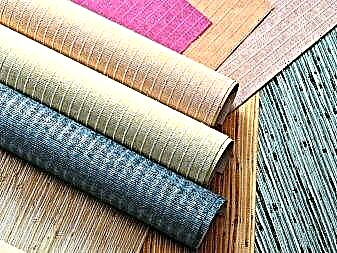

Wallpaper should completely cover the entire width of the door slope, taking into account the overlap of the line of the corner, so that you can cut off the excess at any time. Wallpaper can be textured, embossed and even have an interesting mother of pearl shimmer. They will look very beautiful and elegant. But try to use dull wallpaper for the decor of door slopes, which can also be washed and cleaned. This is due to the fact that dust and dirt from the street very often accumulate near the front door.

